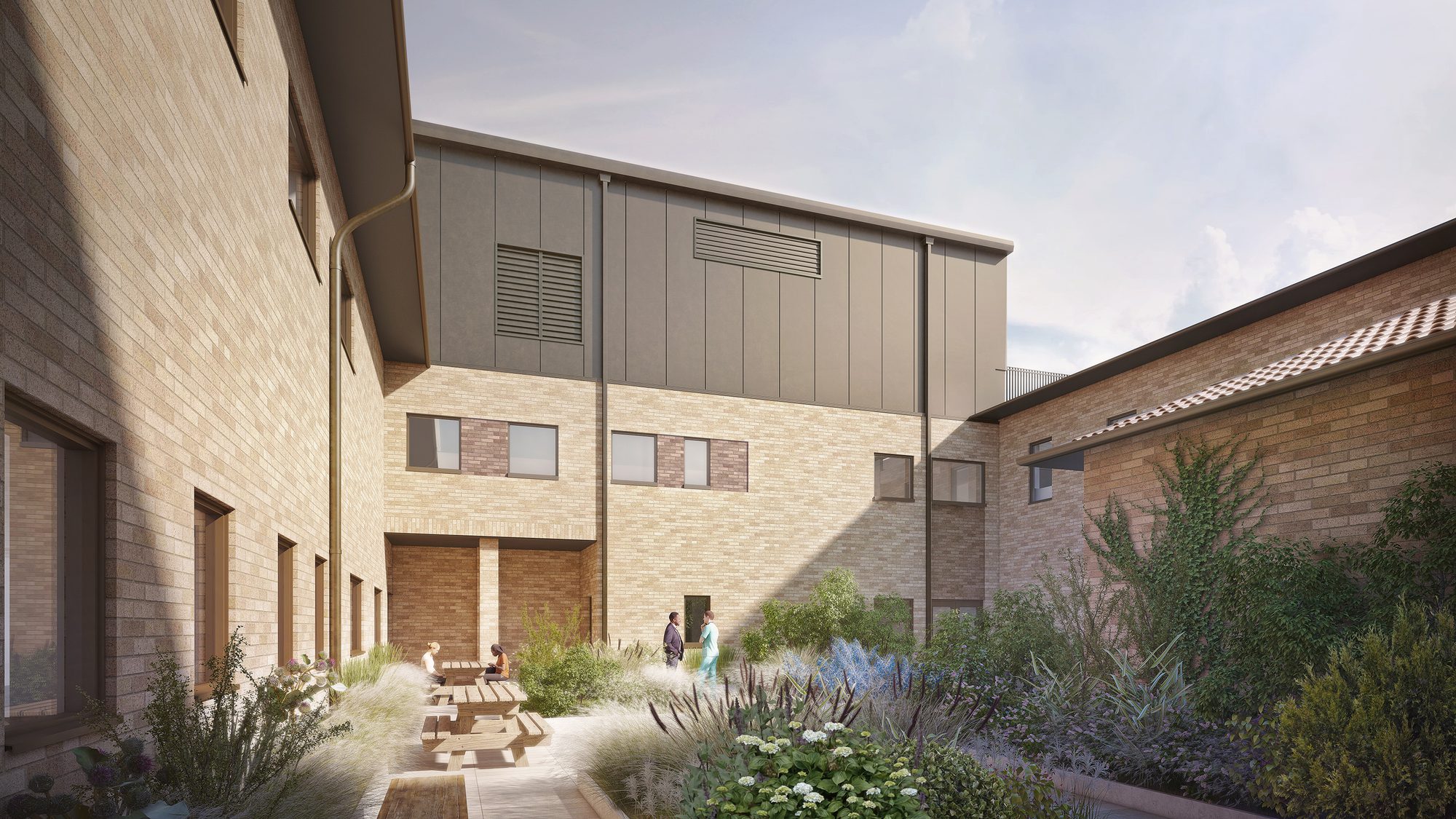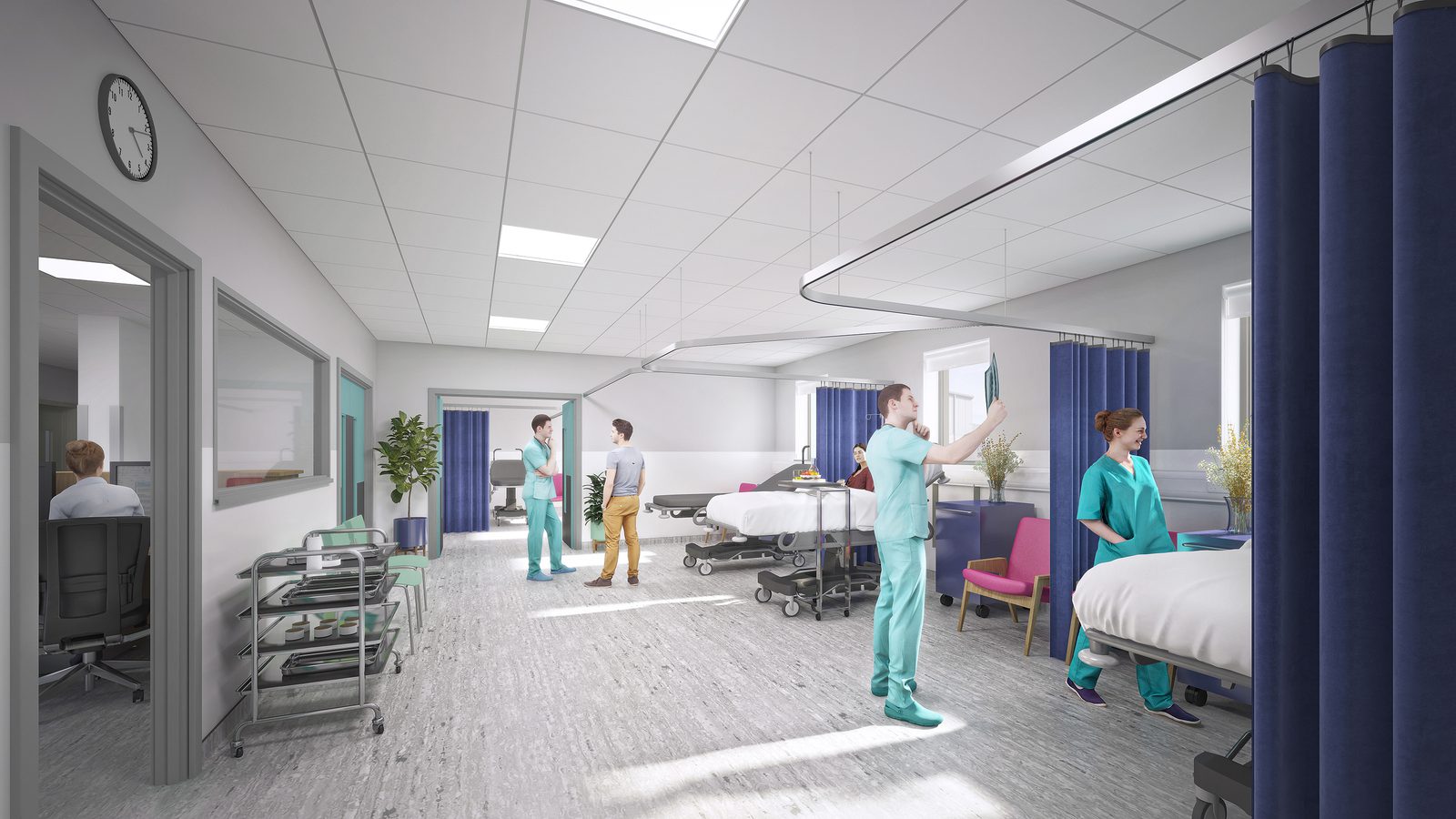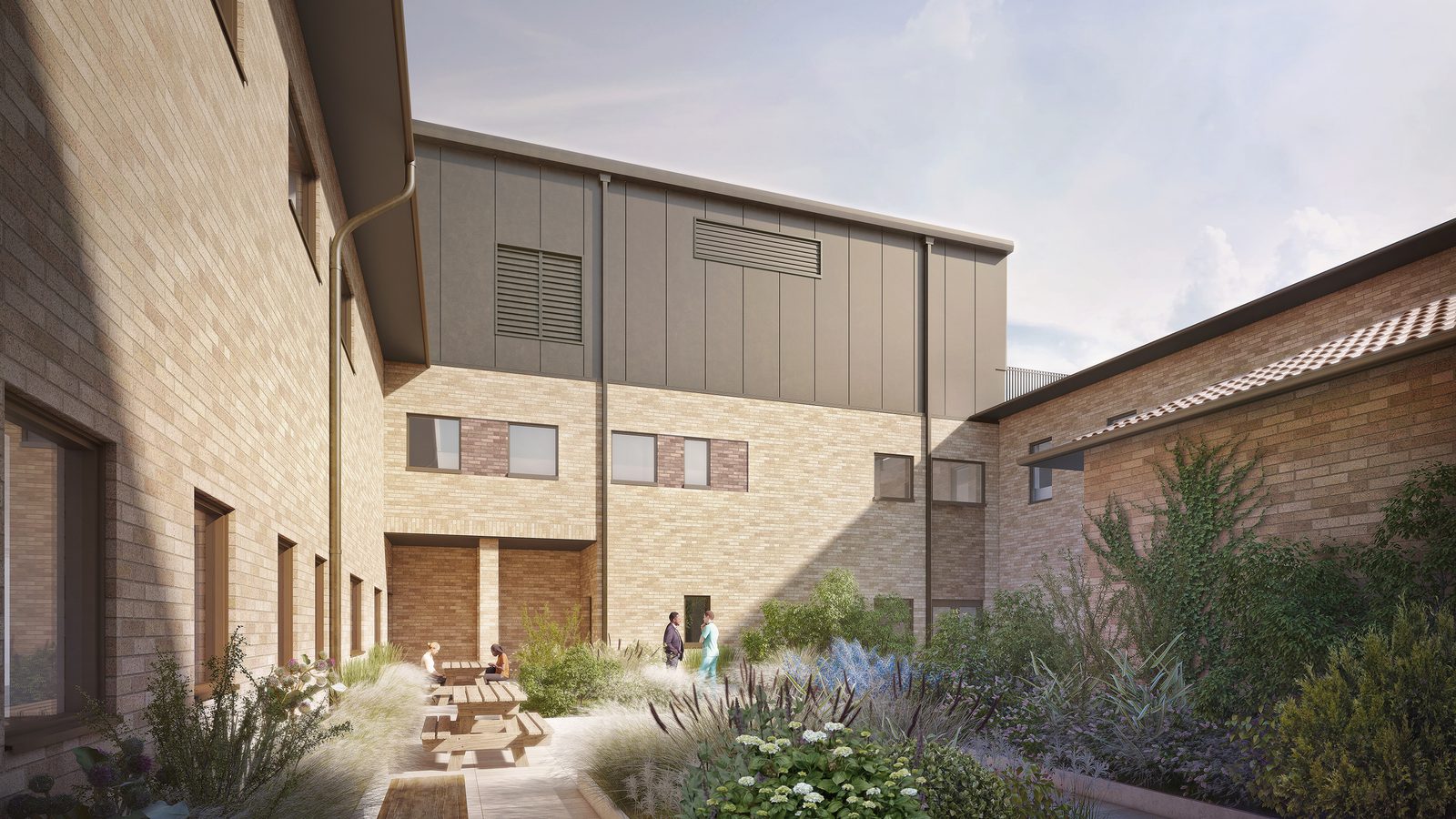Thought Leadership
Decarbonisation and the future of the healthcare estate
by Gareth Banks
Director, Architecture
Gareth Banks and James Wilkinson discuss the strategies NHS estates can adopt to reduce carbon emissions.
With the recent publication of Lord Darzi’s review, the need for the NHS to contribute to a carbon neutral future may appear at first glance, as a potentially distracting objective given current priorities. However, decarbonising the NHS hospital estate presents significant opportunities, as well as challenges, as we strive to create a greener and more sustainable healthcare sector.
To achieve this goal, the NHS has a range of interventions and strategies at its disposal, which actively support the general direction of travel suggested by Lord Darzi, from energy efficient retrofit, adopting renewable energy, and repurposing estates, to adopting new technologies and changing the way healthcare is delivered.
What targets has the NHS set?
The NHS has a significant role to play in reducing the UK’s carbon emissions says Gareth. The NHS contributes around 4% of the total UK carbon emissions and in England is responsible for 40% of the public sector’s emissions.[1]
Huge progress has been made in reducing carbon emissions. Since 2007, it’s achieved a carbon reduction of 19%, despite an increase in activity.[2] NHS England is aiming to become the world’s first net-zero health service by 2040[3]. To put this into context, NHS England owns totals 6.9 million hectares while its buildings are estimated at 28.4 million m2. It’s a huge undertaking!
Scotland and Wales have also set their own sustainability goals; NHS Scotland has set a target to be net zero by 2040 and NHS Wales has committed to a 34% reduction by 2030 to meet a wider goal of a net zero public sector by 2030.
The NHS must reduce its carbon footprint without compromising patient care, which makes it a complicated challenge given the size of the estate.”
Gareth Banks
Regional director, architecture healthcare lead, AHRWhat issues do the NHS face when it comes to decarbonising their estate?
The NHS is vast, within NHS England’s hospital estate there are 220 general acute hospitals, 49 specialist hospitals and 246 community hospitals.[4] In Wales, there are 130 hospitals and Scotland totals 216 hospitals. There are yet more GP practices, community providers, mental health trusts and ambulance providers.
The age and condition of the buildings has resulted in an inefficient estate that needs repurposing. Many buildings are no longer fit for purpose and don’t meet the demands of modern healthcare. To decarbonise properties, we’ll need to develop strategies for repurposing existing buildings and constructing new ones where necessary, but also improve energy efficiency, which will reduce operational costs, freeing up budgets to improve care. We are currently refurbishing the existing theatres and increasing theatre numbers and specification, through a new build addition at the extensive CAVOC University Hospital, Llandough, see below.
At the national level, the infrastructure around existing buildings will present challenges to implementing some of the measures required for decarbonisation (e.g., installing heat pumps requires increased electricity capacity). Wider collaboration between governmental departments will be necessary if this is to be achieved
At the local level, the large and complex estates, the changes required will present a significant undertaking, putting pressure on already stretched budgets to realise the envisaged level of decarbonisation. Therefore, decarbonisation needs to be considered alongside planned redevelopment work, repairs and maintenance plans. The choice of interventions need to be balanced against capital cost, energy savings and payback period.
Find out more about how we are working to futureproof the NHS through repurposing their existing estate.
 CAVOC University Hospital, Llandough
CAVOC University Hospital, LlandoughWhat interventions should healthcare estate teams be thinking about when retrofitting estates?
The NHS estate team can invest in energy efficiency measures and low carbon technology to support retrofit programmes. Initiatives include improving building insulation and upgrading glazing, investing in energy efficient appliances and lighting, upgrading HVAC systems and installing heat pumps to heat buildings. Smart meters can help monitor energy usage and identify efficiency savings whilst the application of Artificial Intelligence to Building Energy Management Systems (BEMS) can tackle heating and lighting inefficiencies using those sensors to gather and react to improved data.
Renewable energy sources are also an option, such as solar panels, passive solar design, or wind turbines in locations where there are favourable wind conditions and a suitable plot of land. Another option is investing in hybrid or HVO (Hydrogenated Vegetable Oil) back-up generators and battery technology to store excess renewable energy.
How do we consider embodied carbon in the retrofit and construction of hospitals?
Conducting comprehensive carbon assessments and benchmarking of hospital estates can provide valuable insights, according to James. This analysis helps identify areas with high embodied carbon and enables targeted interventions, such as energy-efficient retrofitting to reduce operational carbon and the implementation of sustainable construction practices.
By considering carbon emissions from the initial design stage, NHS estates managers can identify ways to minimise embodied carbon in both new and refurbished hospitals. This includes selecting low-carbon materials, optimising building layouts for efficient material usage, and considering the long-term carbon impact of construction decisions.
Low-carbon material choices, such as responsibly sourced timber, recycled or reclaimed materials, and low-carbon concrete alternatives like Concretene, can significantly reduce the embodied carbon of hospital buildings.
Embracing circular economy principles is another powerful strategy. By promoting the reuse, recycling, and repurposing of materials within the hospital estate, the NHS can reduce the demand for new materials and minimise waste generation.
The NHS can engage with industry partners, including surveyors, architects, engineers and contractors. By sharing knowledge and leveraging the expertise of these experts, the NHS can access innovative solutions for reducing embodied carbon in hospital estates.
Find out how our retrofit toolkit can help you to make informed decisions in prioritising decarbonisation plans.
By embracing a collaborative and innovative approach, we can reimagine how space is utilised and make a positive impact on sustainability while improving the overall experience for patients, staff, and the community.”
Gareth Banks
Regional director, architecture healthcare lead, AHRWhat impact does rethinking how space is used have?
The NHS could breathe new life into existing spaces by repurposing them [link to repurposing blog] for more energy-efficient uses. For instance, it might convert old buildings into energy centres or repurpose empty wards for more appropriate accommodation which can utilise the existing building infrastructure for smaller spaces. Moving administrative functions off the acute sites or to the periphery, can release the much-needed space in the clinical areas, which can allow existing departments to grow and expand.
 Medipark, Blackburn
Medipark, BlackburnOur plans for Medipark in Blackburn at the East Lancashire Hospital’s NHS Trust are an example of this. Training facilities have been relocated from the main hospital building to a new facility less than 100 metres away. It provides more efficient use of space by combining medical teaching, research and workspace and allowing the hospital to focus on the delivery of acute care. An added benefit has been the new facility has allowed for collaboration between the trust, university and business.
At the Princess Royal Day Case Elective Hub (PRH) in Telford, we have helped the trust convert administration space into four state-of-the-art theatres and recovery spaces. The design gives the flexibility to provide more compact clinical services on the site and allows non-critical office accommodation to be moved offsite.
Technology as a catalyst for achieving decarbonisation
We can reduce the total footprint of the estate by embracing technology and telehealth to care for patients. Where the role or the task allows, staff could be allowed to work from home reducing travel and space requirements. Telehealth can facilitate the provision of certain services online. For instance, the NHS is currently piloting a project in Leeds to use virtual wards to provide care to patients who would otherwise need to be admitted to hospital. This is expected to reduce the need for hospital beds by 20%.[5]
When designing a new building, sustainability and designing flexibility for future alternative uses for that space should be a priority. Trusts need to fully assess the whole life carbon cost of any new development, also taking into consideration the use and maintenance of the building.
Using low-carbon materials, energy-efficiency measures and renewable energy sources will be important. By integrating these elements from the outset, we can ensure that future medical facilities are environmentally responsible and contribute to a healthier planet.
Encouraging staff and patients to change behaviours is an important part of the decarbonisation journey.
As well as the introduction of more energy efficient appliances, waste and recycling strategies, digital records can help to reduce the use of paper, which can help to reduce carbon emissions from the production and disposal of paper.”
James Wilkinson
Director and building consultancy healthcare lead, AHR
Decarbonising the estate isn’t just about the building but also changing behaviours. How do we do this?
As well as the introduction of more energy efficient appliances, waste and recycling strategies, digital records can help to reduce the use of paper, which can help to reduce carbon emissions from the production and disposal of paper.
NHS England has launched the “Healthier Planet, Healthier People” campaign[6] encouraging staff and patients to make changes to their behaviour, such as using public transport, recycling, as eating less meat.
Pressure on hospital parking is an issue for trusts, with many hospitals constructed in eras when there were less cars on the road. Each trust is required to develop a “Green Travel Plan”[7], which sets out how they will reduce their carbon emissions from travel. This includes providing cycle storage and showers, encouraging the use of public transport, park and ride schemes and offering car-pooling schemes. Active Travel England (ATE) will have to be consulted on planning applications for any major development of over 7,500 m² or where the development area is 5 ha or more.
Embracing technology can also reduce the need for patients to visit hospitals or clinics for check-ups, which can also help to reduce carbon emissions from transportation. Virtual appointments are one such example, as well as remote monitoring which allows healthcare professionals to monitor patients’ health remotely using devices such as wearable sensors. Delivering more health services within the community will also encourage people to access services locally rather than visiting hospitals when care isn’t available from their GP.
How can we better integrate primary and acute care to help with the decarbonisation of the NHS?
Lord Darzi, recognises the need to move healthcare out of acute settings. If realised, this change with also have a direct impact on the carbon footprint of the NHS. Travel to and from hospitals is one of the biggest generators of carbon emissions for the NHS. As well as the use of telehealth and remote monitoring to reduce travel to hospitals for appointments, providing more preventative care in the community can reduce the number of people admitted to hospitals, says Gareth. For example, the NHS is investing in community-based services, such as health centres and walk-in clinics, to provide more preventive care closer to home. The new government looks set to continue the initiatives of the previous government with the expansion of Community Diagnostic Centres (CDC). Following a GP referral, these centres help diagnose illnesses such as cancer and heart disease more quickly than waiting for a hospital referral. We have been working with Shrewsbury and Telford Hospital NHS Trust to deliver a new CDC which will see elective diagnostic tests delivered away from the acute hospital and separately from urgent diagnostic scans.
References
- https://www.bma.org.uk/what-we...
- https://www.longtermplan.nhs.u....
- https://www.property.nhs.uk/se...
- https://www.england.nhs.uk/nhs...#
- NHS England » Providing rapid care to people in their own home rather than going to hospital, through a frailty virtual ward in Leeds
- https://www.england.nhs.uk/gre...
- https://www.england.nhs.uk/gre...
Posted on:
Oct 8th 2024
Topics:
Share on
Related Articles

Podcast
Investigating the challenges faced when decarbonising the NHS
Guest Speakers: Des Keighan, Swansea Bay University Health Board, Gareth Banks, AHR
Date: 6 Jun 24
Hosted by Victoria Shepherdson
Associate Director, Architecture

Podcast
How can healthcare design improve staff wellbeing, retention and job satisfaction across the NHS?
Guest Speakers: Victoria Head, Archus, Dr Barney Senasinghe, Archus, Victoria Shepherdson, AHR
Date: 9 Oct 24
Hosted by Gareth Banks
Director, Architecture

Thought Leadership
Repurposing the NHS estate: Transforming healthcare spaces for the future
To deliver our current and future healthcare needs, the transformation of their vast estate is a key priority for the NHS.
Date: 30 Sept 24
by Gareth Banks
Director, Architecture

Podcast
Exploring innovative approaches to repurposing the NHS estate, to improve health and wellbeing
Guest Speakers: Gareth Banks and Victoria Shepherdson from AHR
Date: 18 Oct 24



